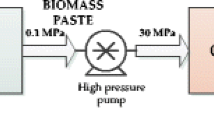Abstract
A techno-economic assessment of an upgrading procedure and outtake of a pre-hydrolysate in a presumed dissolving pulp mill was performed. Pre-hydrolysis of spruce wood chips in pilot scale produced input data for energy and mass balances and was performed with and without subsequent membrane filtration to produce hydrolysate fractions rich in galactoglucomannan and with some lignin. The hydrolysate is a viable raw material for the production of renewable thin oxygen barrier films as demonstrated herein in the formulation of free standing films with very low oxygen permeability at both moderate and high relative humidities. Approximately 50,000 ton dry solid upgraded pre-hydrolysate suitable for production of oxygen barriers could be produced according to the presumed dissolving pulp mill producing about 500,000 air dry ton dissolving pulp per year and applying a liquor to wood ratio of 4:1. Utilization of the pre-hydrolysis liquor hence adds value to and realizes the dissolving plant as a biorefinery. A sensitivity analysis indicates that the market price of the upgraded pre-hydrolysate has the largest positive effect on the return on investment for separation and upgrading of a pre-hydrolysate. Increased investment cost and increased annuity factor show negative effects.




Similar content being viewed by others
References
Dahlman O, Edlund U, Albertsson AC, Lindblad MS, Parkaas J (2009) Utilization of a wood hydrolysate. EP 2067793/WO 2009068525 A1
FitzPatrick M, Champagne P, Cunningham MF, Whitney RA (2010) A biorefinery processing perspective: treatment of lignocellulosic materials for the production of value-added products. Biores Technol 101:8915–8922
Gehmayr V, Schild G, Sixta H (2011) A precise study on the feasibility of enzyme treatments of a kraft pulp for viscose application. Cellulose 18:479–491
Gütsch JS, Sixta H (2011) Purification of eucalyptus globulus water prehydrolysates using the HiTAC process (high-temperature adsorption on activated charcoal). Holzforschung 65:511–518
Hamaguchi M, Kautto J, Vakkilainen E (2013) Effects of hemicellulose extraction on the kraft pulp mill operation and energy use: review and case study with lignin removal. Chem Eng Res Des 91(7):1284–1291
Hasan A, Yasarla R, Ramarao BV, Amidon TE (2011) Separation of lignocellulosic Hydrolyzate Components Using Ceramic Membranes. J Wood Chem Technol 31:357–383
ISO 1762 (2001) Paper, board and pulps—Determination of residue (ash) on ignition at 525 °C. http://www.indexmundi.com/commodities/?commodity=wood-pulp&months=120¤cy=eur Visited 2013-11-20
Janzon R, Puls J, Bohn A, Potthast A, Saake B (2008) Upgrading of paper-grade pulps to dissolving pulps by nitrogen extraction: yields, molecular and supramolecular structures of nitrogen extracted pulps. Cellulose 15:739–750
Jönsson A-S, Nordin A-K, Wallberg O (2008) Concentration and purification of lignin in hardwood kraft pulping liquor by ultrafiltration and nanofiltration. Chem Eng Res Design 86:1271–1280
Koivula E, Kallioinen M, Preis S, Testova L, Sixta H, Mänttäri M (2011) Evaluation of various pretreatment methods to manage fouling in ultrafiltration of wood hydrolysates. Sep Purif Technol 83:50–56
Koivula E, Kallioinen M, Sainio T, Antón E, Luque S, Mänttäri M (2013) Enhanced membrane filtration of wood hydrolysates for hemicelluloses recovery by pretreatment with polymeric adsorbents. Biores Technol 143:275–281
Metso automation: http://www.metso.com/automation/pp_prod.nsf/WebWID/WTB-050701-2256F-46EA1?OpenDocument
Miller KS, Krochta JM (1997) Oxygen and aroma barrier properties of edible films: a review. Trends Food Sci Technol 8:228–237
Novotny M, Nuur C (2013) The transformation of pulp and paper industries: the role of local networks and institutions. Int J Innov Reg Dev 5:41–57
Persson T, Jönsson AS (2009) Fouling of ultrafiltration membranes during Isolation of Hemicelluloses in the Forest Industry. Sch Res Exch. Article ID: 624012
Richter GA (1956) Some aspects of prehydrolysis pulping. Tappi 39:193–210
Rousset P, Aguiar C, Labbé N, Commandré JM (2011) Enhancing the combustible properties of bamboo by torrefaction. Biores Technol 102:8225–8231
Ryberg YZ, Edlund U, Albertsson AC (2011) Conceptual approach to renewable barrier film design based on wood hydrolysate. Biomacromolecules 12:1355–1362
Ryberg YZ, Edlund U, Albertsson AC (2012) Retrostructural model to predict biomass formulations for barrier performance. Biomacromolecules 13:2570–2577
Saadatmand S, Edlund U, Albertsson AC, Danielsson S, Dahlman O (2012) Pre-hydrolysis in softwood pulping produces a valuable biorefinery fraction for material utilization. Environ Sci Technol 46:8389–8396
Saadatmand S, Edlund U, Albertsson AC, Danielsson S, Dahlman O, Karlström K (2013) Turning hardwood dissolving pulp polysaccharide residual material into barrier packaging. Biomacromolecules 14:2929–2936
Saeed A, Jahan MS, Li H, Liu Z, Ni Y, Van Heiningen A (2012) Mass balances of components dissolved in the pre-hydrolysis liquor of kraft-based dissolving pulp production process from Canadian hardwoods. Biomass Bioenergy 39:14–19
Schild G, Sixta H (2011) Sulfur-free dissolving pulps and their application for viscose and lyocell. Cellulose 18:1113–1128
Stocker M (2008) Biofuels and biomass-to-liquid fuels in the biorefinery: catalytic conversion of lignocellulosic biomass using porous materials. Angew Chem Int Edit 47:9200–9211
TAPPI T222 om-11 (2011) Acid-insoluble lignin in wood and pulp
TAPPI T249 cm-09 (2009) test method, Carbohydrate composition of extractive-free wood and wood pulp by gas-liquid chromatography
Wallmo H, Theliander H, Jönsson AS, Lindgren K (2008) Lignin separation—WaCheUp final report. Chalmers University, Lund University, STFI-Packforsk
Yam KL (2010) The Wiley encyclopedia of packaging technology. Wiley, New York
Zhang Z, Britt IJ, Tung MA (2001) Permeation of oxygen and water vapor through EVOH films as influenced by relative humidity. J Appl Polym Sci 82:1866–1872
Acknowledgments
We thank FORMAS (Project Number 2009-2009), Södra Innovation, Södra Skogsägarnas stiftelse för forskning, utveckling och utbildning, and Tetra Pak for financial support. Södra Cell AB is thanked for kindly providing the spruce chips.
Author information
Authors and Affiliations
Corresponding authors
Electronic supplementary material
Below is the link to the electronic supplementary material.
10570_2014_239_MOESM1_ESM.doc
Electronic Supplementary Material. SEC chromatograms and 1H NMR spectra of the spruce wood hydrolysates SWH0 and SWH10-B. TGA, DMA, and DSC thermograms. FTIR spectra and microscopy imaging of a spruce wood hydrolysate based film
Rights and permissions
About this article
Cite this article
Jansson, M., Danielsson, S., Saadatmand, S. et al. Upgrading of wood pre-hydrolysis liquor for renewable barrier design: a techno-economic consideration. Cellulose 21, 2045–2062 (2014). https://doi.org/10.1007/s10570-014-0239-x
Received:
Accepted:
Published:
Issue Date:
DOI: https://doi.org/10.1007/s10570-014-0239-x



